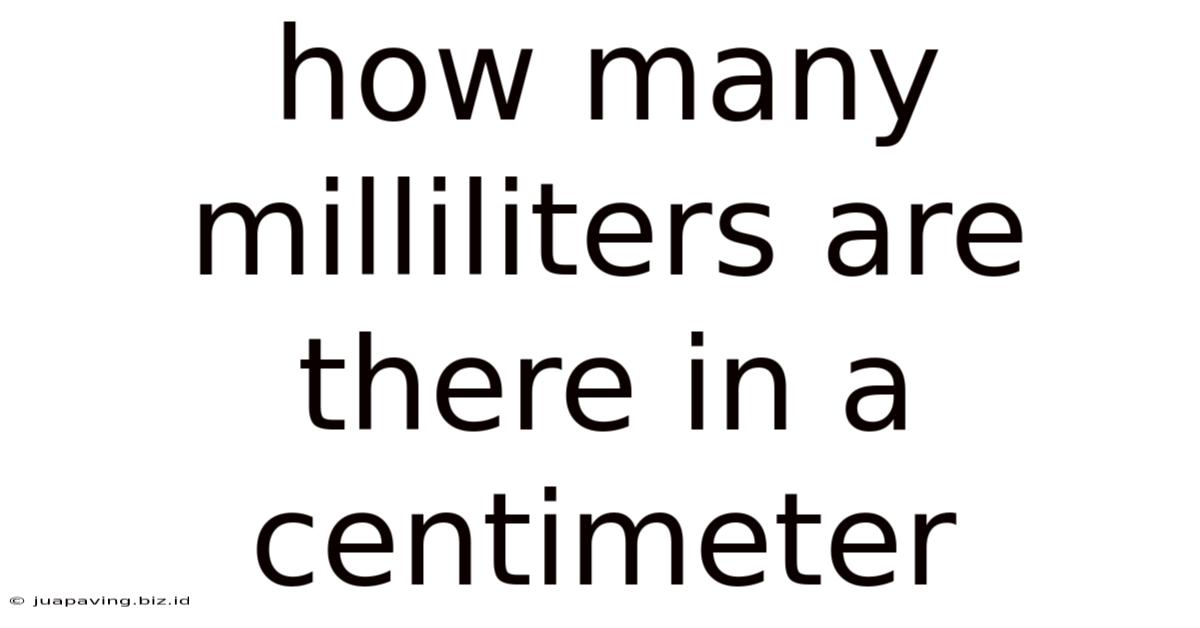How Many Milliliters Are There In A Centimeter
Juapaving
May 09, 2025 · 4 min read

Table of Contents
It's impossible to directly convert milliliters (ml) to centimeters (cm) because they measure different things. Milliliters measure volume while centimeters measure length. It's like asking how many apples are in an orange – they're fundamentally different units. However, we can relate them if we're talking about the volume of a specific three-dimensional shape. This article will explore this relationship, clarify the difference between volume and length, and delve into the calculations needed to determine the volume in milliliters given the length in centimeters, focusing on common shapes.
Understanding the Difference: Volume vs. Length
Before we proceed, it's crucial to understand the distinction between volume and length:
-
Length (cm): This measures a single dimension – the distance between two points in a straight line. Think of measuring the length of a table or the height of a person.
-
Volume (ml): This measures the three-dimensional space occupied by an object or substance. It describes how much space something takes up. A milliliter is a unit of volume, often used for liquids but applicable to solids and gases as well.
Calculating Volume from Length: The Importance of Shape
To relate milliliters and centimeters, we need to know the shape of the object. The formula for calculating volume differs significantly depending on the shape. Let's explore some common shapes and the calculations involved:
1. Cubes and Rectangular Prisms
Cubes and rectangular prisms are the simplest shapes to work with. Their volume is calculated as:
Volume = Length x Width x Height
Since length, width, and height are all measured in centimeters (cm), the resulting volume will be in cubic centimeters (cm³). To convert cubic centimeters to milliliters, we use the following conversion:
1 cm³ = 1 ml
Therefore, for a cube or rectangular prism, if you know the length, width, and height in centimeters, you can directly calculate the volume in milliliters.
Example: A rectangular container has a length of 10 cm, a width of 5 cm, and a height of 2 cm.
Volume = 10 cm x 5 cm x 2 cm = 100 cm³ = 100 ml
2. Cylinders
Cylinders are common shapes found in various applications. Their volume is calculated using the formula:
Volume = πr²h
Where:
- π (pi): Approximately 3.14159
- r: The radius of the cylinder's circular base (in cm)
- h: The height of the cylinder (in cm)
The resulting volume will be in cubic centimeters (cm³), which again equals milliliters (ml).
Example: A cylindrical container has a radius of 3 cm and a height of 10 cm.
Volume = π x (3 cm)² x 10 cm ≈ 3.14159 x 9 cm² x 10 cm ≈ 282.74 cm³ ≈ 282.74 ml
3. Spheres
Spheres are three-dimensional objects with a perfectly round shape. Their volume is calculated as:
Volume = (4/3)πr³
Where:
- π (pi): Approximately 3.14159
- r: The radius of the sphere (in cm)
Again, the result will be in cubic centimeters (cm³), equivalent to milliliters (ml).
Example: A spherical tank has a radius of 5 cm.
Volume = (4/3) x π x (5 cm)³ ≈ (4/3) x 3.14159 x 125 cm³ ≈ 523.60 cm³ ≈ 523.60 ml
4. Irregular Shapes
Calculating the volume of irregular shapes is more challenging. Direct measurement using length in centimeters is not sufficient. Instead, you'd typically use methods like water displacement:
- Fill a graduated cylinder with a known volume of water (in ml).
- Submerge the irregular object completely in the water.
- Measure the new water level in the graduated cylinder.
- Subtract the initial water level from the final water level. The difference represents the volume of the irregular object in milliliters.
Practical Applications and Considerations
Understanding the relationship between milliliters and centimeters (through volume calculations) is essential in various fields:
- Chemistry and Biology: Measuring the volume of liquids and solutions in experiments.
- Engineering: Designing containers and structures with specific capacities.
- Medicine: Dispensing medications and calculating dosages.
- Cooking and Baking: Measuring ingredients accurately.
Important Considerations:
- Accuracy: The accuracy of your volume calculation depends entirely on the accuracy of your length measurements. Use precise measuring tools for better results.
- Significant Figures: When performing calculations, pay attention to significant figures to avoid reporting an overly precise answer.
- Units: Always be mindful of the units you're using. Ensure consistency throughout your calculations.
Conclusion: The Interplay of Volume and Length
While you can't directly convert milliliters to centimeters, understanding the relationship between volume and length is crucial for calculating volumes of various shapes. By using the appropriate formulas and accurately measuring length in centimeters, you can determine the volume in milliliters. Remember that the shape of the object dictates the formula used, and for irregular shapes, water displacement is a reliable method for volume determination. Accurate measurements and attention to units ensure reliable results in diverse applications. This knowledge forms a fundamental basis for many scientific and everyday tasks involving volume and capacity.
Latest Posts
Latest Posts
-
Where In A Plant Cell Is Chlorophyll Found
May 09, 2025
-
Which Of The Following Is Monomial
May 09, 2025
-
Choose The Correct Html Tag For Largest Heading
May 09, 2025
-
Name A Musical Instrument Type Or Die
May 09, 2025
-
Why Do Atoms Have No Electric Charge
May 09, 2025
Related Post
Thank you for visiting our website which covers about How Many Milliliters Are There In A Centimeter . We hope the information provided has been useful to you. Feel free to contact us if you have any questions or need further assistance. See you next time and don't miss to bookmark.